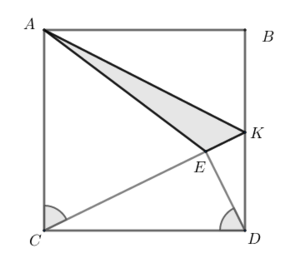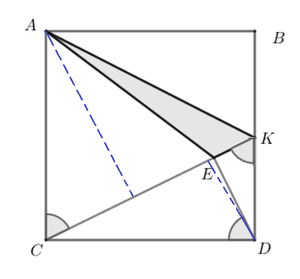A Square Problem .

A B C D is a square and K is midpoint of ∣ B D ∣ . Point E is on ∣ C K ∣ such that ∠ E D C = ∠ E C A . What is the ratio of the area of △ A K E to the area of A B C D ?
The answer is 0.1.
This section requires Javascript.
You are seeing this because something didn't load right. We suggest you, (a) try
refreshing the page, (b) enabling javascript if it is disabled on your browser and,
finally, (c)
loading the
non-javascript version of this page
. We're sorry about the hassle.
2 solutions

Note that △ D E K and △ C D E are similar. Since C D D K = 2 1 , the ratio of the areas of the two triangles [ C D E ] [ D E K ] = 4 1 . Since △ D E K and △ C D E are sharing the same height, this means that C E E K = 4 1 ⟹ E K = 5 C K . Again △ A K E and △ A C K are sharing the same height, ⟹ [ A C K ] [ A K E ] = 5 1 . But [ A B C D ] [ A C K ] = 2 1 . Therefore [ A B C D ] [ A K E ] = [ A C K ] [ A K E ] × [ A B C D ] [ A C K ] = 5 1 × 2 1 = 1 0 1 = 0 . 1 .
∠ E D C = ∠ E C A Hence ∠ E C D = ∠ E D K and ∠ D E C = 9 0 ∘
Let ∣ C D ∣ = x and ∣ E D ∣ = y ; ∣ K D ∣ ∣ C D ∣ = ∣ K E ∣ ∣ E D ∣ = ∣ E D ∣ ∣ C E ∣
2 x x = ∣ K E ∣ y = y ∣ C E ∣ = 2 hence ∣ K E ∣ = 2 y and ∣ C E ∣ = 2 y
Let F be point on [ C K ] such that [ A F ] ⊥ [ C K ]
∣ A C ∣ = ∣ C D ∣ = x Hence △ A F C and △ E C D are congruent and ∣ A F ∣ = 2 y
Area of △ A K E is 2 2 y ⋅ 2 y = 2 y 2
Area of A B C D is x 2 and 5 y 2 = x 2 ⇒ x 2 y 2 = 5 1 (Pythagoras Theorem)
Required ratio is x 2 2 y 2 = 2 x 2 y 2 = 1 0 1 = 0 . 1